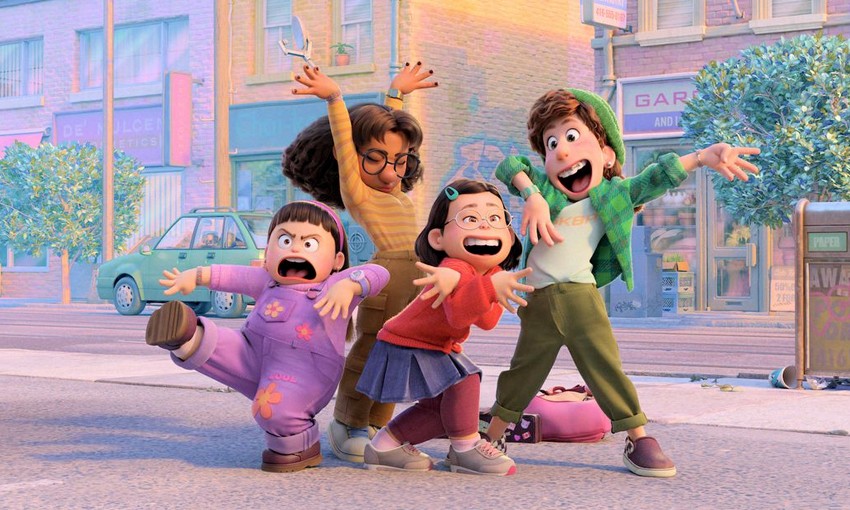09/03/2022
09/03/2022
For better and worse, “Turning Red” is like no Pixar film before it. The film, directed by Domee Shi, who made the lovely Oscarwinning short “Bao,” is the first Pixar movie directly solely by a woman. Its leadership team, including producers and art departments, is entirely female. And its protagonist, 13-year-old Meilin Lee (voiced by Rosalie Chiang), is a Chinese-Canadian eighth-grader in the throws of puberty. For Pixar, a factory of childhood whimsy designed to make adults cry, “Turning Red” fills in more than a few blind spots. Not only is the movie deeply rooted in a female and Asian-North American perspective, it wades into a chapter of life unfrequented by Pixar. This is the first film by the studio in which, for example, a sanitary pad is offered. And it’s the first — history take note — to feature twerking. The best thing about “Turning Red” is how it broadens the horizons of the 36-year-old animation powerhouse with a refreshing vantage point and some new moves.

If some of Pixar’s greatest movies have used high concepts to illustrate existential quandaries, “Turning Red” (which like the previous two Pixar releases is streaming only; it debuts Friday on Disney+) is one of the studio’s most specifically drawn films. Set in Toronto in 2002, Mei is a high-achieving, straight-A student — in an introductory montage, a teacher describes her as “a very enterprising, mildly annoying young lady” — with a solid, supportive group of friends: Miriam (Ava Morse), Abby (Hyein Park) and Priya (Maitreyi Ramakrishnan). But possibly the most dominant relationship in Mei’s life is with her mother (Sandra Oh). She’s a domineering but loving parent whose high standards for her daughter have somewhat stifl ed the anxious Mei. She keeps certain feelings — like the onset of hard-to-control urges, particularly when it comes to a popular boy band named 4-Town — hidden from her mother. “I do make my own moves,” Mei says. “It’s just that some of my moves are also hers.” But it’s getting harder to keep some of those feelings inside for Mei. Her mother finds a notebook under her bed with swooning drawings of 4-Town, and immediately irrationally blames an older teen boy for being a bad infl uence. Then one morning, Mei awakens to find the transformation that’s been occurring within her has manifested itself: She turns into a big, fl uffy red panda — and a walking metaphor for menstruation and other developments of young womanhood.
Animation
That “Turning Red” pivots this way — with Mei, as panda, cowering in the bathroom with her mother knocking outside — is a fairly radical move in the typically sanitized world of studio animation. But Shi, a longtime animator at Pixar, has never been one to shy away from a dramatic plot device. Her “Bao” conceived a mother-son tale in a dumpling-comes-alive allegory that culminated, surprisingly, with the mom eating her dumpling son in a fit of denial over him growing up and leaving home. “Turning Red” shifts its point of view to the child in such a relationship, but it’s likewise about the push-and-pull for the maturing offspring of an overprotective parent.
The red panda transformation, which Mei learns she can suppress by moderating her emotions, connects to her heritage, as well. The Lees live in one of the oldest Chinese temples in Toronto, and that setting is just one way “Turning Red” plays with balancing cultural assimilation with preservation. Mei soon discovers that panda alteregos run in the family. Her mother, and their other female relatives, have known the same struggles with expression and repression. (Some similar themes about not holding in your feelings were brought more vividly to life another recent Disney hit, “Encanto.”) Where I think “Turning Red” mainly misses is with the mom. The movie is structured for her to be the primary foil and friend of Mei, but her character isn’t much more than an assortment of Asian tiger mom tropes. That leaves little to propel “Turning Red” other than the inevitable empowerment of Mei. There are delights along the way: a rooftop skip through Toronto, with a dose of wuxia magic; the rich, lovable design of Mei’s Totoro-sized panda; the close-knit companionship of her friends. But “Turning Red” is surprisingly free of humor or the kind of visual wit that has long been a Pixar hallmark.
It could be that, if we’re talking about representing hard-to-tame adolescent urges in monster form, “Turning Red” — bold as it may be — can’t come close to matching the messy comic farce of “Big Mouth,” the far less family-friendly but much more true-to-life animated series that paired seventh graders with lascivious “hormone monsters.” It isn’t easy — or maybe even possible — to do puberty justice with a PG rating. But “Turning Red” does nail one rite of female adolescence with remarkable accuracy: the boy band. With radio-ready pop tunes by Billie Eilish and Finneas (who voices one of the singers), 4-Town is about as pitch perfect as an NSNYC knockoff can be. But just as good is Mei’s mother’s cutting critique of them as “glittery delinquents with their … gyrations.” I seriously doubt I will ever listen to my daughters blast BTS without muttering her line to myself. (By Jake Coyle AP)


